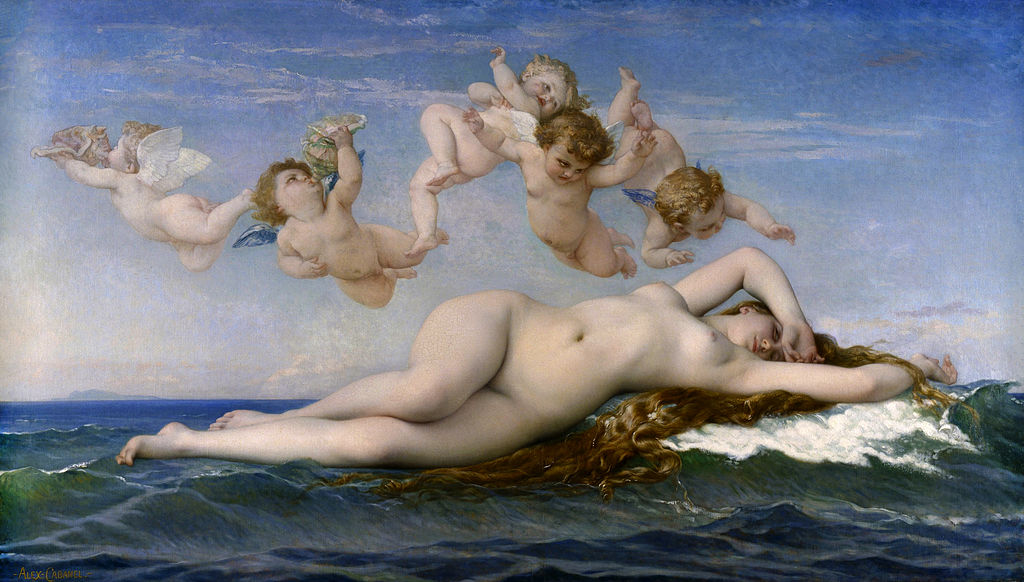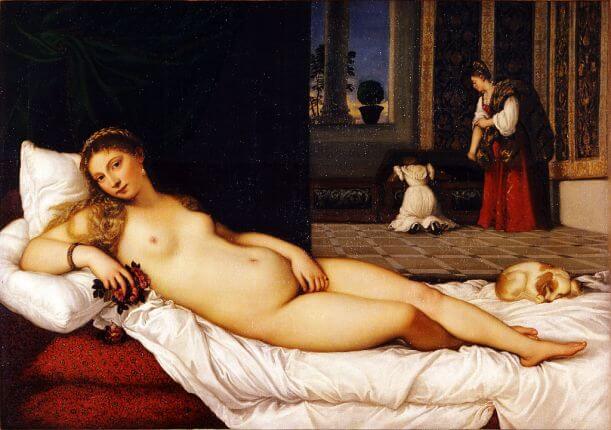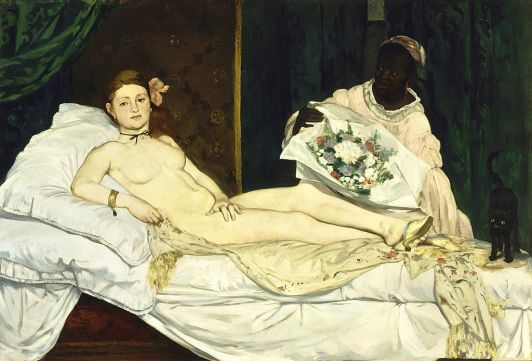|
Where? Room 2 of the Musée d’Orsay
When? 1863 What do you see? A beautiful Venus is born from the foam of the sea. It looks as if she has just awakened from a deep slumber. She languidly rests her head upon a small wave that is beginning to form on the far right. The waters seem to conform to her twisted contrapposto, perfectly following the shape of her waist. Upon first glance, her eyes are shut. But a closer look reveals that they are half-open, pointed upwards as she looks into the crook of her right elbow. Her golden hair flows from beneath her left arm, floating beside her in the blue-green waters. Above her is a pastel sky decorated with thin clouds and five cherubs that are celebrating and announcing her arrival with horns made of seashells. The three cherubs closest to her face peer over her body with playful curiosity, arms stretched out, perhaps preparing to wake her. Backstory: Alexandre Cabanel exhibited The Birth of Venus in the Paris Salon in 1863 in a “Salon of Venuses”. During this time, many artists were painting female nudes shrouded in the mythology of the birth of Venus. The European idealized female nude, a tradition that traces back to the Venus of Urbino by Titian, was experiencing a revival in the 19th century in works like Cabanel’s, as well as the Grande Odalisque by Ingres, and the Maja Desnuda by Goya. The mysticism of the story gave artists room to produce semi-erotic works without offending the public. Cabanel’s Venus is posed in a much more provocative way than Olympia by Manet, but because of Manet’s more realistic and confrontational take on his nude, he received a great deal of criticism in the same year.
What is contrapposto? Contrapposto is a pose that was developed by the Greeks. In contrapposto, the figure rests its weight on one leg and bends the other. The axis of the shoulders and the hips are positioned in opposite directions to create a sense of dynamism and depth. This creates a natural resting pose that makes the figure come alive.
Who is Alexandre Cabanel? Alexandre Cabanel was a French painter born in 1823 in Montpellier, in the south of France. When he was seventeen years old, he enrolled in the Ecolé des Beaux-Artes in Paris. Following his first exhibition in 1844, Cabanel was awarded the Prix de Rome. His work was quickly popularized at the Paris Salon. Cabanel primarily painted in the Academic style and drew inspiration from the Rococo art movement. His works centered around classical, religious, and historical themes. The Birth of Venus, his most famous painting, was exhibited at the Paris Salon and later purchased by Napoleon III. In his later life, Cabanel served as a juror for the Salon and returned to the Ecolé des Beaux-Artes as a teacher. He died in Paris in 1889 at the age of 65. Fun fact: Following the creation of the original, Alexandre Cabanel sold reproduction rights to Adolphe Goupil, an art dealer and publisher. Working with copyist Adolphe Jourdan, Cabanel was able to produce numerous replicas of his take on The Birth of Venus. One of these replicas is on display in the Dahesh Museum in New York. Another one belongs to the Metropolitan Museum of Art but is not on permanent display.
Written by Sabrina Tian
References:
0 Comments
Leave a Reply. |
Categories
All
|
- Home
- Blog
-
Museums
- Alte Pinakothek
- Art Institute of Chicago
- Baltimore Museum of Art
- Barber Institute of Fine Arts
- Bargello
- Barnes Foundation
- British Museum
- Church of Sant’Anastasia
- Cleveland Museum of Art
- Courtauld Institute of Art
- Detroit Institute of Arts
- Frans Hals Museum
- Galleria Borghese
- Gallerie dell'Accademia
- Getty Museum
- Guggenheim
- Hermitage Museum
- Kunsthistorisches Museum
- Kunstmuseum Basel
- Legion of Honor Museum
- Louvre
- Mauritshuis
- Metropolitan Museum of Art
- Musee d’Orsay
- Museum of Fine Arts in Boston
- Museum of Modern Art
- National Gallery in London
- National Gallery of Art
- National Museum in Poznań
- Norton Simon Museum
- Ny Carlsberg Glyptotek
- Palace of Versailles
- Palazzo Pitti
- Palazzo Vecchio
- Petit Palais
- Philadelphia Museum of Art
- Prado
- Pushkin Museum
- Ravenna Art Museum
- Rijksmuseum
- San Diego Museum of Art
- Santa Maria delle Grazie
- St. Peter's Basilica
- Städel Museum
- Statens Museum for Kunst
- Tate Britain
- Tate Modern
- Timken Museum of Art
- Uffizi
- Vatican Museums
- Wallace Collection
-
Artists
- Altdorfer
- Anguissola
- Berlin Painter
- Bosch
- Botticelli
- Boucher
- Bronzino
- Bruegel the Elder
- Brunelleschi
- Cabanel
- Caillebotte
- Canova
- Caravaggio
- Carpeaux
- Cezanne
- Cimabue
- David
- Degas
- Delacroix
- De Maria
- Donatello
- El Greco
- Fontana
- Fra Angelico
- Fragonard
- Gauguin
- Gentileschi
- Gericault
- Gonzalez-Torres
- Goya
- Hals
- Hogarth
- Hokusai
- Ingres
- Leonardo da Vinci
- Lippi, Filippo
- Longhi, Barbara
- Lorrain
- Makovsky
- Manet
- Massys
- Matisse
- Merian
- Michelangelo
- Mochi
- Modigliani
- Monet
- Panini
- Parmigianino
- Perugino
- Picasso
- Pisanello
- Raphael
- Rembrandt
- Renoir
- Reynolds
- Rivera
- Rodin
- Rubens
- Scultori
- Seurat
- Steen
- Tintoretto
- Titian
- Toulouse-Lautrec
- Turner
- Uccello
- Van der Weyden
- Van Dyck
- Van Eyck
- Van Gogh
- Van Hemessen
- Vasari
- Velazquez
- Vermeer
- Veronese
- Vigée Le Brun
-
Locations
- Books
- About Us



